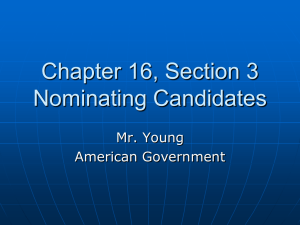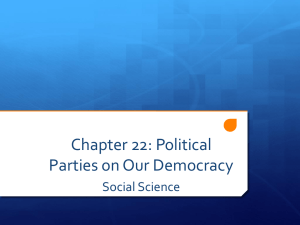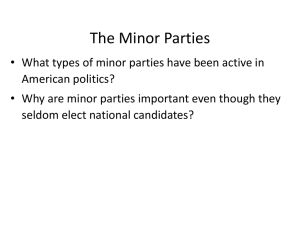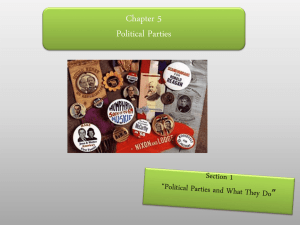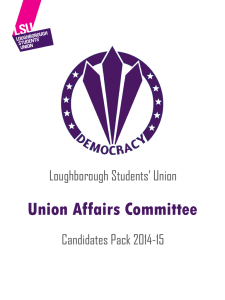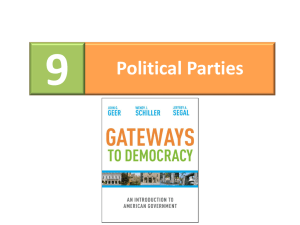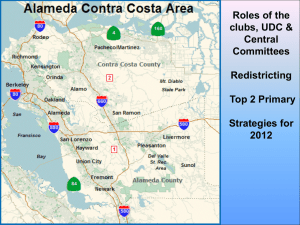Chapter 16 - Madera Unified School District
advertisement
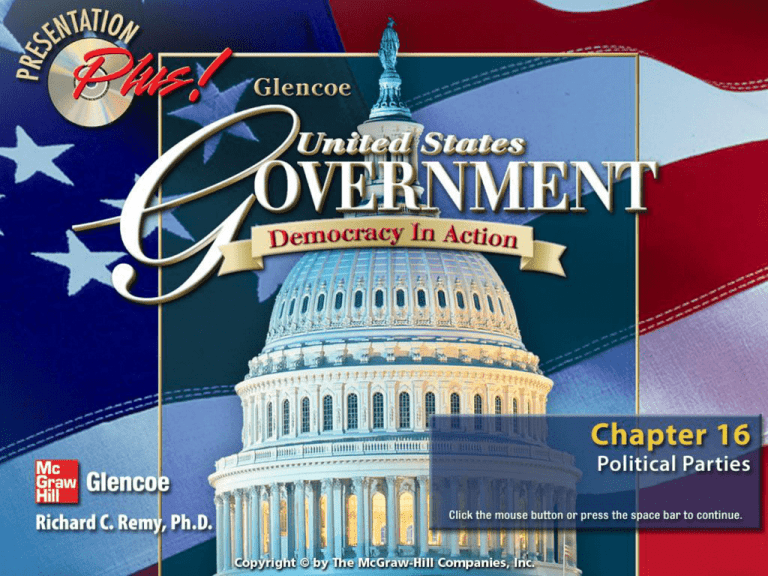
Chapter Focus Section 1 Development of Parties Section 2 Party Organization Section 3 Nominating Candidates Chapter Assessment Chapter Objectives • Development of Parties Summarize the role of political parties in American politics. • Party Organization Describe the organization and function of American political parties. • Nominating Candidates Discuss the advantages and disadvantages of the four methods of nominating candidates. Development of Parties Key Terms political party, theocracy, ideologies, coalition government, third party, single-member district, proportional representation Find Out • What is a multiparty system and how does it affect governing? • Why have third parties played only a minor role in American politics? Development of Parties Understanding Concepts Growth of Democracy Could Americans have participated as effectively in government without political parties? Section Objective Summarize the role of political parties in American politics. Political parties began in the early stages of American politics, but even then they were not always popular—especially with their own members. Thomas Jefferson expressed this attitude when he said, “If I could not go to heaven but with a party, I would not go at all.” I. Parties and Party Systems (pages 453–454) A. A political party is a group of people with broad common interests who organize to win elections and to control and influence governments and their policies. B. In a one-party system, the party, in effect, is the government; such one-party systems are usually found in authoritarian governments. C. In nations with a multiparty system, several political parties compete to control the government and must often form coalitions to do so. D. In the dozen nations with a two-party system, two major parties dominate the government. I. Parties and Party Systems (pages 453–454) What problems do political parties face in a multiparty system? One party rarely gets enough support to run the government, and coalitions often break down. II. Growth of American Parties (pages 454–455) A. Although many of the Founders distrusted factions, by the end of President Washington’s second term, two political parties had formed. B. The two-party system in the United States changed as political parties appeared and declined. C. On the eve of the Civil War, the Republican Party was born; after the war, it dominated the national scene with the Democrats the minority party. II. Growth of American Parties (pages 454–455) D. During the Great Depression, the Democratic Party gained power and remained the majority party for most of the next 50 years. E. The Republican Party gained the presidency in 6 of the next 9 terms, starting in 1968, and in 1994 regained control of both houses of Congress. II. Growth of American Parties (pages 454–455) II. Growth of American Parties (pages 454–455) What effect did the Civil War and the New Deal have on the two major political parties? The Civil War made Republicans the majority party; the New Deal did the same for Democrats. III. The Role of Minor Parties (pages 455–457) A. Third parties have been part of the American political scene since the early years of the Republic. B. All third parties have one thing in common: They do not believe the two major parties are meeting certain national needs. C. In general, third parties fall into one of three categories: the single-issue party, the ideological party, and the splinter party. D. Occasionally, third parties influenced the outcome of national elections by drawing enough votes to tip the balance to one of the major parties. III. The Role of Minor Parties (pages 455–457) E. Third parties’ ideas often were later adopted by the major parties. F. Third parties face many obstacles: 1) It is difficult for them to get on the ballot, 2) most voters support the major parties, and 3) raising campaign funds is difficult. III. The Role of Minor Parties (pages 455–457) III. The Role of Minor Parties (pages 455–457) What are some reasons for and against voting for third party candidates? For: to address issues that the major parties ignore. Against: slight chance of electing a candidate. Checking for Understanding 1. Main Idea Use a graphic organizer like the one below to identify three types of political party systems and how they affect governing. One party—lack of differences; lack of choices. Two party—stability; fewer choices. Multiparty—diverse ideologies represented; instability when coalitions disagree. Checking for Understanding Match the term with the correct definition. ___ D theocracy A. electoral district in which only one candidate is elected to each office ___ F ideologies B. a system in which several officials are elected to represent the same area in proportion to the votes each party’s candidates receives ___ C coalition government ___ E third party ___ A single-member district ___ B proportional representation C. formed by several parties who combine forces to obtain a majority D. a government dominated by religion E. any political party other than one of the two major parties F. basic beliefs about life, culture, government, and society Checking for Understanding 3. Identify Bull Moose Party, American Independent Party. The Bull Moose Party, or Progressive Party, was a splinter party led by former president Theodore Roosevelt that broke away from the Republican Party in 1912 and disappeared after Roosevelt lost the presidential election. The American Independent Party is a third party that won 13.5 percent of the vote in 1968 and is believed to have swayed the narrow election of Republican candidate Richard Nixon. Checking for Understanding 4. Identify three obstacles facing third parties. Obstacles include difficulty in getting on the ballot in all 50 states, single-member districts, and difficulty garnering sufficient finances. Critical Thinking 5. Making Inferences Why might the National Organization for Women want to choose and run a third-party candidate? Answers will vary but may include to get recognition for women’s issues from the two parties, to bring public attention to a specific issue, to gain a plank on one of the two parties’ platforms, and so on. Growth of Democracy Imagine you have been named to a committee to plan a new government for a former colony. The structure of this government will influence the development of political parties. Consider the advantages and disadvantages of no parties, one-party, two-party, and multiparty systems. Write a speech explaining your choice. Party Organization Key Terms independent, precinct, precinct captain, ward, state central committee, national convention, national committee, patronage Find Out • How are parties organized on the national, state, and local levels? • How do political parties assist in educating the public? Party Organization Understanding Concepts Political Processes What role do the Republican and Democratic Parties play in the day-to-day operations and processes of the government? Section Objective Describe the organization and function of American political parties. Famous American humorist Will Rogers told an audience this political joke in the 1920s. “I don’t belong to an organized political party—I’m a Democrat.” Rogers’ quip was half serious, since to many Americans, then and now, both parties sometimes seem to lack unity. I. Membership and Organization (pages 458–460) A. Both Republicans and Democrats are organized into 50 state parties and thousands of local parties, as well as a national party. B. Voters may become members of a party when they register to vote, usually joining the party whose ideas and candidates, in general, they support. C. Party membership involves no duties or obligations beyond voting; however, some members contribute money or do volunteer work. I. Membership and Organization (pages 458–460) D. The basic local unit in the party’s organization is the precinct, or voting district, and wards made up of several adjoining precincts. E. The county level is the one in which the party is most united, and the county chairperson usually exercises a good deal of political power in the county; yet counties are the weakest link in the party’s organizational chain because they are largely run by volunteers. I. Membership and Organization (pages 458–460) F. The state central committee, composed of members from the party’s county organizations, is the most important part of the party in each state; its main function is to help elect the party’s candidates for state office. G. The national convention and the national committee are the two main parts of the party’s national organization. H. The national party chairperson, elected by the national committee, manages the daily operations of the national party. I. Membership and Organization (pages 458–460) I. Both parties have independent campaign committees for Congress. I. Membership and Organization (pages 458–460) What are some reasons for becoming an active member of a political party? To promote issues you support, to associate with active people, to promote the future direction of the party. II. Political Party Functions (pages 460–462) A. Political parties recruit candidates to run for office; both parties are candidate-oriented rather than issue-oriented. B. Political parties bring important issues to the attention of the public, publish the party’s position on these issues, maintain Web sites, and help form public opinion. C. Personal attacks against the other party’s candidates sometimes obscure issues; since many Americans are not well informed on issues or the candidates, political party membership simplifies their choices. II. Political Party Functions (pages 460–462) D. Political parties play a key role in running the government; Congress and state legislatures carry on their work on the basis of party affiliation. E. Political parties also dispense patronage, including jobs, contracts, and appointments to government positions. F. The party out of power assumes the role of “watchdog” over government. G. Because parties need to draw support from many different and sometimes conflicting groups, parties encourage compromise and adopt moderate policies with mass appeal. II. Political Party Functions (pages 460–462) How well do political parties fulfill their function of educating the public? Answers will vary. See Educating the Public on text page 461. Checking for Understanding 1. Main Idea Use a graphic organizer like the one below to show the three levels at which each major political party functions. From the inside-out: local or county; state; national. Checking for Understanding Match the term with the correct definition. ___ D independent A. a voting district ___ A precinct B. representatives from the 50 party organizations who run a political party ___ E ward ___ C state central committee ___ B national committee ___ F patronage C. group usually composed largely of representatives from the party’s county organizations D. a voter who does not support any particular party E. a large district comprised of several adjoining precincts F. the practice of granting favors to reward party loyalty Checking for Understanding 3. Identify party county chairperson, party state chairperson, party national chairperson. The party county chairperson is appointed by the county committee to handle the county party’s daily affairs and is key in determining which candidate receives the party’s support. The party state chairperson is chosen by the state central committee and helps elect the party’s candidate for state government offices. The party national chairperson, elected by the national committee, manages the daily operations of the national party. Checking for Understanding 4. Analyze the role of political parties at the national, state, and local levels. On all levels, political parties recruit volunteers, select candidates to run for office, and raise money. Critical Thinking 5. Understanding Cause and Effect What are the advantages and the disadvantages of the system of patronage? Possible advantages: parties can reward and control their supporters, people who contribute time and money will be rewarded; Possible disadvantages: political favors are dispensed to reward party loyalty and are not given on the basis of merit, can lead to corruption Political Processes Prepare for a debate on the following statement: The two-party system has outlived its usefulness. Choose either the pro or con side of the issue and prepare arguments for the side you chose. Pair up with a classmate who has prepared arguments opposing yours and debate the issue. Nominating Candidates Key Terms caucus, nominating convention, boss, direct primary, closed primary, open primary, plurality, runoff primary, ticket, platform, planks Find Out • How are primaries conducted as a method of choosing candidates? • What are the processes followed at a national nominating convention? Nominating Candidates Understanding Concepts Political Processes Primaries and nominating conventions are democratic methods of selecting candidates. What are some drawbacks? Section Objective Discuss the advantages and disadvantages of the four methods of nominating candidates. In 1924, the Democratic Party’s nominating convention dragged on for three weeks before it chose a candidate for president. The deep divisions in the party forced the weary delegates to keep trying until they finally chose John W. Davis on the 103rd vote. Davis, a former Congressman, was virtually unknown to the public, and he lost the election to Republican Calvin Coolidge by nearly a two-to-one margin. I. How Candidates Are Selected (pages 464–466) A. In 19 states party leaders hold caucuses to select candidates for public office. B. As party caucuses came under attack, the nominating convention to choose candidates became popular. C. The direct primary is the method most used by parties today to nominate candidates; most states hold closed primaries, in which only party members vote, but some states have open primaries, in which any voter can participate. I. How Candidates Are Selected (pages 464–466) D. Primary elections, run according to state law and held at regular polling places, are used to select party candidates for the House, Senate, governor, and other state and local offices. E. A person can file a petition, signed by a specified number of voters, to be placed on the ballot; however, the caucus or convention candidate of the major parties has an advantage because of party backing and resources. I. How Candidates Are Selected (pages 464–466) Do you favor open or closed primaries? Explain. Answers will vary. See Primary Elections on text page 465. II. Presidential Nominations (pages 466–468) A. Every four years, each major party holds a nominating convention to choose candidates for president and vice president in the November general election. B. Before nominating conventions, congressional caucuses selected presidential candidates. C. Presidential primary elections operate under a wide variety of state laws and party rules in selecting candidates to run for office. II. Presidential Nominations (pages 466–468) D. Criticisms of presidential primaries include: 1) the process extends over too long a period; 2) the primaries focus on the image of a candidate more than on the issues; 3) relatively few people vote in primaries, thus the winner may not be as popular as the victory would indicate; 4) primaries often result in one-sided conventions that become rubber stamp operations. II. Presidential Nominations (pages 466–468) How well do presidential primaries serve as a means of nominating candidates? Answers will vary. See Criticisms of Presidential Primaries on text page 467. III. The National Convention (pages 468–470) A. Each party’s national committee chooses the site and date of the convention and decides how many votes each state will have. B. Many of the delegates who assemble at the convention are already pledged to a candidate, though some are not. C. On the evening of the opening day, an important party member gives the keynote address, a speech intended to unite the party for the coming campaign; in the next day or two, the delegates listen to committee reports and speeches about them. III. The National Convention (pages 468–470) D. Each party’s rules committee governs the way the convention is run; most delegates accept the rules committee’s report, but sometimes bitter battles are fought by delegates who oppose decisions made by the rules committee. E. The credentials committee must approve the delegations from each state, and sometimes lively fights have occurred between rival delegations for a state’s seats. F. A committee on permanent organization selects the permanent chairperson and other permanent officials for the convention. III. The National Convention (pages 468–470) G. The platform committee is assigned the important task of writing the party’s platform—a statement of its principles, beliefs, and positions on vital issues. H. The highlight of the convention is the selection of the party’s candidate for president. In recent years, front-runners have had enough committed delegates that it was known they would be the party’s nominee, and they were selected on the first roll call ballot. III. The National Convention (pages 468–470) I. The vice presidential nomination sometimes creates some suspense because the presidential candidate’s choice, who is always selected by the delegates, is not known in advance. J. The vice presidential nominee usually is chosen to balance the ticket, with a person who has a personal, political, or geographic background different from the presidential candidate’s. K. The convention adjourns after the presidential and vice presidential candidates have delivered their acceptance speeches, intended to unify the party and appeal to the national television audience. III. The National Convention (pages 468–470) Should the major television networks televise only the high points of the Democratic and Republican national conventions or have gavel-to-gavel coverage? Explain. Answers will vary. Students should consider how informative conventions are. Checking for Understanding 1. Main Idea Use a chart like the one below to show four ways candidates for office can get on the ballot and why each method has drawn criticism. Caucuses—considered undemocratic; Nominating convention—subject to control by bosses; Primary elections—extend over too long a time, candidates’ image seems more important than the issues; Petition—advantage to party-backed candidates Checking for Understanding Match the term with the correct definition. ___ C caucus ___ A nominating convention ___ B boss ___ F plurality ___ D ticket ___ E plank A. an official public meeting of a party to choose candidates B. a powerful party leader C. a private meeting of party leaders to choose candidates for office D. the candidates for president and vice president E. a section of a political party platform F. the largest number of votes in an election Checking for Understanding 3. Identify convention delegates, rules committee. Convention delegates are party members, pledged to the winning candidate of a presidential party, who become that state’s representatives to the national convention. A rules committee governs the way a party’s convention is run. Checking for Understanding 4. How do states deal with the situation in which no primary candidate wins a majority of votes? The top two candidates compete in a runoff election. Checking for Understanding 5. How is each major party’s presidential candidate chosen at its national nominating convention? In an alphabetical roll call, each state delegation calls out the delegates’ votes. The candidate with the majority becomes the nominee. If no one wins a majority, additional roll calls are taken. Critical Thinking 6. Making Generalizations What historical and political changes in society have influenced presidential nominating methods? Generalizations should point out that as American society became more democratic, so did nominating methods. Political Processes Create a poster that presents a democratic and cost-efficient system for selecting nominees for president. Reviewing Key Terms Insert the correct terms into the sentences. Some terms will be used more than once. bosses plank ideology caucus ticket national convention platform ideology 1. A political party’s ___________________ is plank expressed in each ___________________ of the ___________________ that it adopts at the platform national convention to select its ___________________ ___________________. ticket national convention replaced 2. Although the ___________________ caucus the party ___________________ in choosing its ___________________ , the party’s ticket bosses ___________________ continued to influence the nomination process. Recalling Facts 1. What is the main function of the two major political parties? The main function of the two political parties is to select candidates for public office and present them to the voters for approval. 2. What are the responsibilities of a precinct captain within a political party? A precinct captain organizes party workers to distribute information about the party and its candidates and to get voters to the polls. Recalling Facts 3. What role does the political party out of power assume? The party out of power in the legislative or executive branch acts as a watchdog, observing the party in power, criticizing it, and offering its own solutions to political problems. 4. What is the difference between open and closed primaries? In a closed primary only members of a political party can vote in that political party’s primary. In an open primary all voters can vote in any party’s primary, but they can only vote in one party’s primary. Recalling Facts 5. Identify the three types of third parties and identify a party of each type. single-issue: focuses exclusively on one major social, economic, or moral issue and is often short-lived (Liberty, Free Soil) ideological: focuses on overall change in society rather than a single issue, giving it a broader focus, but it is more extreme, so more limiting, and yet possibly more long-lived (Labor, Communist, Libertarian) splinter: splits away from one of the major parties over a disagreement, which can be issueoriented, ideological, or personal, and is shortlived because it fades away when candidate does (Bull Moose) Understanding Concepts 1. Growth of Democracy Why have third parties had so little success in the United States? Minor parties face difficulty getting on the ballot in all 50 states, getting their candidate elected to office in single-member districts, and garnering adequate public financing. Minor parties often do not enjoy political support in all parts of the country. Understanding Concepts 2. Political Processes Why are many Americans uninformed about the issues in a campaign? Primary elections have made the image of the candidates more important than the issues, and media coverage tends to play up candidates’ personalities rather than their positions on important questions. Also, political parties simplify elections by helping uninformed people decide how to vote. Understanding Concepts 3. Political Processes Why is a primary election better than a party caucus for selecting candidates? Party caucuses only involved party leaders and became controlled by party bosses. Primary elections allow all interested voters to vote and are therefore more democratic. Critical Thinking 1. Understanding Cause and Effect The two major parties are criticized as being out of touch with the needs of many Americans. How might a successful third party affect the two major parties? Answers will vary but should note that a third party can challenge the two parties to address an issue, a problem, and so on. Critical Thinking 2. Predicting Consequences Use a chart to analyze the advantages and disadvantages of a national primary to nominate each party’s presidential candidate. Advantages: reduce campaign costs and time; focus on national issues. Disadvantages: weaken parties and federalism; focus even more on national media coverage. Interpreting Political Cartoons Activity 1. What event is this cartoon documenting? In the 1994 congressional elections, voters turned control of both the House and Senate over to the Republicans for the first time in 40 years. Interpreting Political Cartoons Activity 2. What symbols does the cartoonist use? Elephant hugging the Capitol represents Republican control of Congress. Interpreting Political Cartoons Activity 3. Why does the elephant seem so jubilant? The 1994 Republican congressional victory represented the first time in 40 years that Republicans controlled both houses of Congress— a jubilant victory. Which minor political party has been the most persistent, offering candidates in every election since 1872? Prohibitionists 1) Republican 2) the Democratic-Republican party from 1801-1829 3) nine 2) Answers will vary. 1) Answers will vary. 3) Answers will vary. 1) law 2) all except Clinton had military service; all had government service 3) Answers will vary. Charting Governments and Political Parties Create a table outlining other nations’ systems of government. Use the following headings for the table: Country, Form of Government, Type of Political Party System, Name of Political Party(ies). As you read the chapter, list all nations mentioned and fill in the table with the appropriate information. Research other nations not mentioned in the chapter. Discuss the information you gathered with the class and compare other countries’ governments and political party systems with those of the United States. Political Slogans Many political campaign slogans are more memorable than the candidates themselves. Calvin Coolidge’s slogan “Keep Cool with Coolidge” lives on. In 1932 Herbert Hoover promised “A Chicken in Every Pot, a Car in Every Garage.” Bill Clinton’s reminder to the Republicans helped him win the election by noting that “It’s the Economy, Stupid.” The third-party candidates who received the most votes in United States history were Theodore Roosevelt in 1912 (27.4 percent), Millard Fillmore in 1856 (21.5 percent), and Ross Perot in 1992 (18.9 percent). Perot’s total was the highest in history for a candidate who was not a former president. With such a small number of delegates at stake (29 Democratic and 17 Republican), New Hampshire’s primary is largely a media event. Why? Conventional wisdom once held that the candidate that lost in the New Hampshire primary would lose the presidency. That is the way events unfolded for 40 years until 1992, when Bill Clinton lost in the primary but won the presidency. Another reason New Hampshire has attracted media attention is that it has traditionally held the first presidential primary. But in 2000, two states, Iowa and Alaska, upstaged New Hampshire. Iowa held its presidential caucus on January 24, the same day that Alaska held its presidential primary. More About Running for Office Running for office is expensive. The 2000 election campaigns were the most expensive in history totaling an estimated $3 billion in expenditures by the two major parties, political action committees (PACs), and other political organizations. The median expenditure on a House campaign was $520,112, a small decline from $559,807 in 1996. However, the median expenditure on a Senate campaign rose to $4.5 million, up from $3.5 million in 1996. Party Time The United States has more than 50 third parties (including some that have never fielded candidates). They range from the America First Party to the World Socialist Party of the U.S. and represent nearly every ideology. The American Patriot Party hopes to repeal the federal income tax. The Light Party calls for a national emphasis on solar power and organic foods. The Revolution wants to end global warming by using “clean” energy, abolish the CIA, and fund scientific programs that help people. The Southern Party would like to create an independent nation made up of Southern states. Single-Member Districts vs. Proportional Representation Write a four-paragraph essay about the advantages and disadvantages of the single-member district and proportional representation. (You may wish to do additional research.) Exchange papers with other students and critique one another’s arguments. SETTING UP THE DEBATE Research current news items about campaign financing and bring three articles to class. Give a brief oral presentation describing the main points of each article. Then brainstorm the advantages and disadvantages of limits on campaign financing. Choose sides—for or against limits—and form two groups accordingly. Each group should select three members to be the group’s spokespersons and take three minutes to present their case. Then each group should take five minutes to ask the other group five questions, with two minutes for rebuttal of each question. Finally, each group should take two minutes to summarize the main points of its argument. CONCLUDING THE DEBATE Discuss the debating process and evaluate which group was the most effective in presenting its argument, answering the questions, and rebutting the other group’s arguments. Local Political Parties Interview officials of your local political parties (precinct captains, ward officials, and so on). Focus your questions on how the local party is organized and how it relates to state and national party organizations. Linda and Loretta Sanchez Linda Sanchez serves on the House Judiciary Committee, which she indicated as her preferred appointment after her election in 1996. At that time the committee had no Latino representation, even though it dealt with many issues that impact minority groups. Loretta Sanchez has focused much of her attention on issues like economic development, crime reduction, protections for senior citizens, and education. In the course of seeking reforms in this last category, she has personally visited every school in her district. Activity: Create an illustrated time line showing the growing diversity of representation in Congress. Note how growing diversity has affected the legislature and legislative policies. Fannie Lou Hamer Woodrow Wilson Fannie Lou Hamer Fannie Lou Hamer testified before the credentials committee at the 1964 Democratic National Convention saying, “I question America.” Hamer and members of the Mississippi Freedom Democratic Party challenged the all-white delegation sent by the regular Mississippi Democratic Party. Woodrow Wilson Woodrow Wilson won the 1912 Democratic nomination on the forty-sixth ballot. Wilson wrote about his grueling experience, “There ought never to be another Presidential nominating convention. The nomination should be made directly by the people.” Wilson supported a direct national primary. To navigate within this Presentation Plus! product: Click the Forward button to go to the next slide. Click the Previous button to return to the previous slide. Click the Section Back button return to the beginning of the section you are in. Click the Menu button to return to the Chapter Menu. Click the Help button to access this screen. Click the Audio On button where it appears to listen to relevant audio. Click the Audio Off button to stop any playing audio. Click the Exit button to end the slide show. You also may press the Escape key [Esc] to exit the slide show. Presentation Plus! features such as the Reference Atlas, Government Online, and others are located in the left margin of most screens. Click on any of these buttons to access a specific feature. This slide is intentionally blank.

